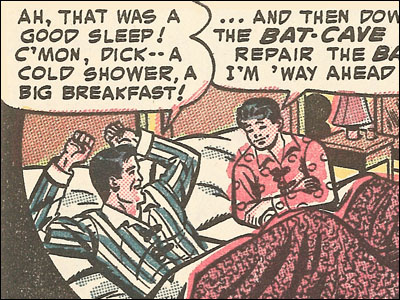Glen Weldon writes about gay subtext in Batman comic books. Yeah, there is some and it's difficult to explain how it got there. The stories where it's noticeable were written and drawn by a number of folks who felt pretty anonymous back then. Their names were not on the work and Bob Kane's was.
Reading those stories, it does not seem to me that any of them — not even Bill Finger, who co-created the feature and wrote more stories than anyone — were particularly interested in steering the direction of those characters or making any sort of personal statement. Their primary goal was to match each other; to all write essentially the same characters, which is what it took to get a script accepted and a check issued.
At any given time, there might have been 4-6 freelance writers producing the scripts and when you're part of a mob like that, about all you can do is to follow what others are doing. My sense is that few if any of them even gave the question of "Who is Batman?" much of a thought. One guy had written Bruce Wayne and his "ward" Dick Grayson working out together so the next guy expanded on that.
I also don't think any of them really thought of these stories took place in the real world. Sex was not part of those tales so no one considered it even as subtext. If you'd asked one of those writers about Batman's love life, they'd have reacted the same way as if they were writing Donald Duck and you asked if he was banging Daisy or where those nephews came from. The question was not relevant to what they were doing.
That was the case through the forties and fifties and some of the sixties — the stories Mr. Weldon is writing about. Later on, you had writers and artists who did try to put Batman and his adventures into a more realistic, adult world and who viewed their job more as individual efforts. Instead of trying to do the same Batman as others working on the character, most of them tried to some extent to do their versions; to shape the hero and his mythos the way they thought it should be. Denny O'Neil in Detective Comics was not writing quite the same Caped Crusader that Bob Haney was writing in The Brave and the Bold or that Frank Robbins was writing in the Batman comic.

For the reader who wants to view it all as a collective work and to see Batman as the sum of the various creators' input, there's a problem. Those writers were not all working in the same building, not all consulting and collaborating. A few of them never even met each other. Many of them were actively trying to not do the other guy's interpretation and to make Batman their own sub-creation, at least in their stories if not everywhere.
In my own experience talking with most of them, I'd say most of them thought that Batman (and Robin and the Joker and Batgirl, etc.) as written by certain other writers was terribly, terribly wrong and in desperate need of course correction. A number of artists, when called upon to illustrate those adventures also changed the way Batman and his world looked and that further changed the way writers approached their work. The biggest artistic changes probably occurred in 1964 when the old "Bob Kane" art style was dumped and replaced a look set by Carmine Infantino, then beginning in 1968 with a grittier look set by Neal Adams. And then later, Frank Miller made it grittier still.
I would guess that I could name fifty people who over the years contributed to the current definition of who and what Batman is. This would include folks who worked on Batman movies and TV shows, both live-action and animated. Weldon notes that the gay subtext of the Batman franchise has come and gone but was quite evident in the films helmed by Joel Schumacher, Batman Forever and Batman & Robin.
With so many different folks putting their stamp on the characters and twisting and turning them, it would be amazing if someone didn't deliberately output a gay-tinged Batman, just as other variations have been inevitable. But I don't think most (if any) of what Weldon writes about in the earlier days was intended. It just kind of all happened the way committees sometimes create something that no participant had in mind.
As I wrote back here, I sometimes feel that corporate-controlled properties are revamped and rebooted so many different ways that they lose their underlying premises. Even the most ardent of Batman fans finds it necessary to ignore certain issues and certain appearances as not being "my Batman." In a way, that might be good because it gives everyone a chance to pick and choose what they want Batman to be. In another way though, if the character can be anything, that makes him kind of nothing.